Ancient Asian perfume blending starts with six core elements: agarwood, sandalwood, frankincense, clove, and wet rice powder. You'll want to grind ingredients into fine powders and mix them with natural binders like honey or makko powder. Store your blends in cool, dark spaces between 60-70°F, and allow them to mature for deeper fragrance profiles. Traditional methods also incorporate sacred resins, exotic flowers, and medicinal herbs for enhanced therapeutic benefits. These time-tested techniques hold even more aromatic secrets.
The Six Critical Tang Dynasty Perfume Elements
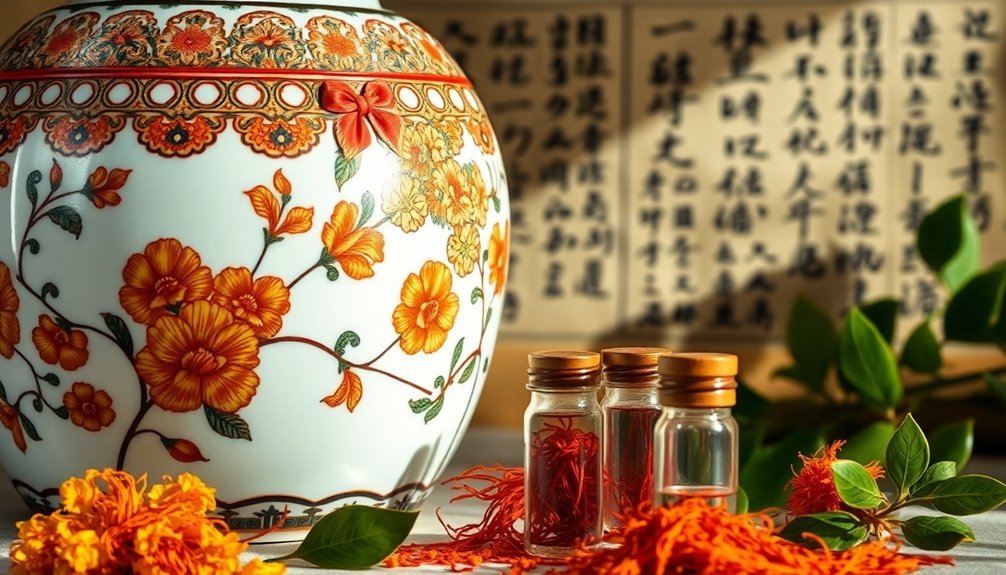
The essence of Tang Dynasty perfumery rested on six fundamental elements that shaped China's aromatic legacy.
You'll find agarwood at the heart of these blends, prized for its intense, lasting fragrance. Sandalwood's buttery sweetness and frankincense's spicy notes created depth, while clove added a powerful aromatic punch. These ingredients were often combined with wet rice powder for optimal consistency.
The mastery wasn't just in the ingredients but in their preparation. You'd need to grind materials into fine powders before blending them with honey to form incense dough.
Then came the essential step of cellaring, where you'd store your creation for months to develop complex scent profiles. This meticulous process reflected both artistic sophistication and spiritual significance, as these fragrances played critical roles in meditation, ceremonies, and trade across the ancient Silk Road.
Sacred Blend Proportions From Han Dynasty Texts
During the Han Dynasty, sacred perfume blends emerged as sophisticated formulations combining rare ingredients like aloe, putchuk, and clove with precious musk and wild honey.
You'll find that these blends weren't just about smelling good – they served multiple purposes in ancient Chinese society.
While specific proportions weren't documented, you'd need to carefully balance each ingredient to achieve the desired fragrance. Ancient perfumers would dilute with ethanol to achieve precise measurements of potent ingredients. The blends would often mature over time, allowing scents to stabilize naturally.
You could use these perfumes for personal grooming, but they also played significant roles in religious ceremonies and social status displays.
The practice of creating these sacred blends influenced later dynasties, especially after Buddhism's arrival, and their ingredients were highly valued along the Silk Road trade routes.
Imperial Palace Aromatic Paste Methods
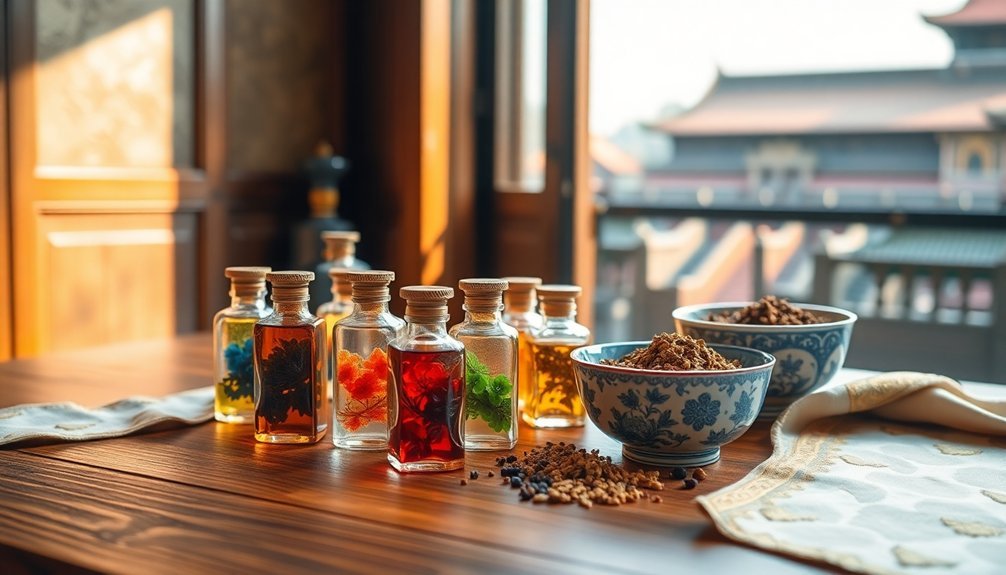
Within the hallowed walls of imperial palaces, master chefs crafted aromatic pastes through meticulous methods that combined premium ingredients like aged mandarin peel, high-quality red beans, and fresh ginger. You'll find their techniques still alive today in prestigious kitchens that maintain ISO 22000:2018 and HACCP certifications. Just as Master Chef Lai Wing Koon has earned his Michelin two stars, these traditional methods continue to evolve with modern expertise.
| Ingredient | Method | Result |
|---|---|---|
| Red Beans | Infused with 20-yr mandarin peel | Rich, citrus-layered paste |
| Black Sesame | Enhanced cooking technique | Soup-like flowing texture |
| Fresh Ginger | Ground to juice extraction | Sharp aromatic filling |
| Green Tea | New formula blending | Intensified aroma |
| Durian | Pure flesh preservation | Natural creamy texture |
These methods weren't perfected overnight – they required hundreds of tests to achieve the perfect lava consistency that flows at room temperature while maintaining traditional authenticity.
Silk Road Spice Integration Techniques
You'll discover how merchants along the Silk Road mastered the art of blending Middle Eastern spices with Asian aromatics, creating entirely new fragrances that bridged cultural traditions.
In their quest to perfect these fusion techniques, traders developed secret methods for combining desert resins like frankincense with exotic Asian ingredients such as sandalwood and patchouli.
These carefully guarded spice integration techniques eventually made their way into imperial palaces, where court perfumers refined them into sophisticated aromatic formulas that would influence perfumery for centuries to come.
Trade Route Aromatic Fusion
As ancient traders traversed the legendary Silk Road, they created an unprecedented fusion of aromatic treasures that would forever change both culinary and perfumery traditions.
You'll find this rich heritage in the blend of sandalwood and patchouli from Asia with Middle Eastern frankincense and myrrh, forming the foundation of oriental perfumes.
These aromatic crossroads weren't limited to perfumery. You can trace how saffron, known as "red gold," merged with rosewater in Persian cuisine, while spices like cardamom, cinnamon, and black pepper transformed dishes across continents.
Today, you're experiencing this ancient legacy when you combine turmeric's earthy notes with cumin's warmth in your cooking.
This integration of Eastern and Western aromatics didn't just shape fragrances and flavors – it drove exploration, economies, and cultural exchange throughout history.
Desert-to-Palace Spice Blending
The masterful art of spice blending emerged from humble desert caravans to opulent palace kitchens along the Silk Road.
You'll discover this ancient wisdom through key techniques still used today: roasting spices over medium-high heat to intensify their flavors, and combining warm, earthy cumin with delicate saffron and aromatic cardamom.
To create authentic blends, you'll want to balance sweet and savory notes, just as traders did when merging Persian, Indian, and Central Asian influences.
Start by roasting your spices until they darken and release their oils. Then, layer flavors strategically – begin with robust spices like turmeric and black pepper as your base, followed by more subtle elements like ginger and coriander.
You're not just mixing ingredients; you're continuing a legacy of cross-cultural culinary artistry.
Merchants' Secret Mixing Methods
While caravans traversed the ancient Silk Road, merchants developed secretive perfume-blending techniques that would forever change Asian fragrance traditions.
You'll find these methods reflected in how they skillfully combined exotic materials like frankincense and myrrh with local ingredients.
You can trace their influence in how they introduced Arabic distillation methods to India, where they'd perfect the creation of complex attars.
These merchants didn't just transport ingredients – they shared knowledge that transformed regional practices.
They'd teach others to blend rosewater and ambergris with indigenous aromatics, creating unique signatures for each territory they visited.
When you explore traditional Asian perfumes today, you're experiencing the legacy of these merchant techniques, where Middle Eastern, Indian, and Chinese methods merged to create sophisticated fragrances that still captivate modern noses.
Ancient Herbal Infusion Secrets
Throughout ancient China's rich history, herbal infusion practices evolved from simple medicinal remedies into sophisticated healing arts documented in classic texts like the *Recipes for 52 Ailments* and *Shennong's Materia Medica*.
The traditional herbalists developed intricate systems for classifying and preparing herbs based on their natures, flavors, and therapeutic actions.
When creating your own herbal infusions, follow these time-tested principles:
- Choose your herbs based on the Four Natures (hot, warm, cool, cold) to match your intended therapeutic effect.
- Combine 9-18 substances in your decoctions, including main herbs, supporting herbs, and catalysts.
- Consider the Five Flavors (acrid, sweet, bitter, sour, salty) and their corresponding organ relationships when blending your infusions.
Buddhist Temple Incense Formulations
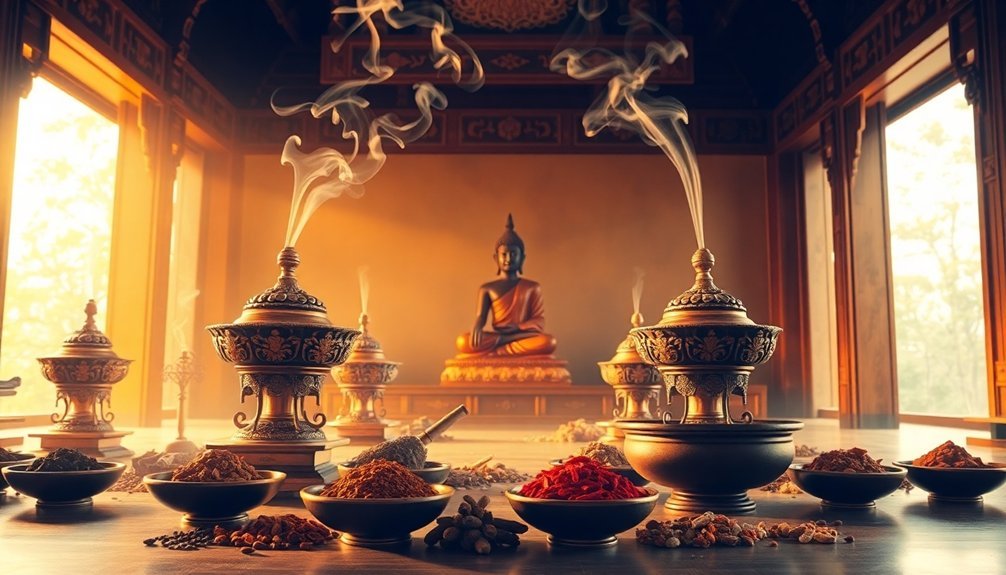
Within Buddhist temples, you'll discover sacred formulations crafted from precious woods like sandalwood and agar wood, along with aromatic resins such as myrrh and frankincense.
Temple practitioners blend these materials daily, following ancient recipes that have been preserved through generations of Buddhist traditions.
The purest meditation blends often combine simple ingredients like cedar, borneol, and medicinal herbs to create an atmosphere that enhances spiritual focus and contemplation.
Sacred Woods and Resins
Since ancient times, Buddhist temples have relied on sacred woods and resins to create their distinctive incense formulations.
You'll find that premium ingredients like sandalwood and agarwood are ground into fine powders, while precious resins such as myrrh and frankincense add depth to these spiritual blends.
Natural binding agents like charcoal and makko powder hold these sacred elements together.
Want to understand the significance of these materials? Here's what makes them special:
- Sandalwood's tranquil properties have made it a cornerstone of Asian spiritual practices for centuries.
- Agarwood, especially valued in Japanese temples, creates a deep, meditative atmosphere.
- Frankincense and myrrh serve dual purposes – they're both aromatic and medicinal, helping to purify spaces while promoting well-being.
Daily Temple Blending Practices
When Buddhist temples prepare their sacred incense blends, they follow time-honored practices that combine spiritual wisdom with precise craftsmanship.
You'll find monks carefully sifting and powdering precious ingredients like red sandalwood, saffron, and rare Tibetan herbs, ensuring each component meets strict quality standards.
To create the perfect blend, you'll need to mix the powdered herbs with makko powder, a natural binding agent from the tabunoki tree.
Once you've combined these elements with water to form a dough, you'll knead and shape it into strips.
The strips must air dry for 2-3 days under controlled conditions.
Throughout this process, you're not just making incense – you're participating in a Buddhist tradition that's been refined by generations of monks following ancient sutras and medicinal texts.
Pure Meditation Scent Formulas
The sacred art of Buddhist temple incense blending relies on precise formulations passed down through generations of monks. You'll find these meditation-focused blends crafted from pure, sustainably sourced ingredients like sandalwood, agar wood, and myrrh, without any chemical additives.
Traditional recipes, often created by Lamas and senior monks, emphasize the perfect balance of aromatherapeutic properties.
Key elements of pure meditation formulas include:
- Base woods (sandalwood, cedar, pine) mixed with premium binders like makko powder
- Sacred resins (frankincense, amber) combined with exotic flowers (snow lotus, hibiscus)
- Medicinal herbs (red orpine, Chinese Caterpillar Fungus) carefully measured for specific therapeutic benefits
Each formula must be precisely mixed and dried for 2-3 days to achieve the perfect burning quality for temple use.
Noble House Perfume Preservation Methods
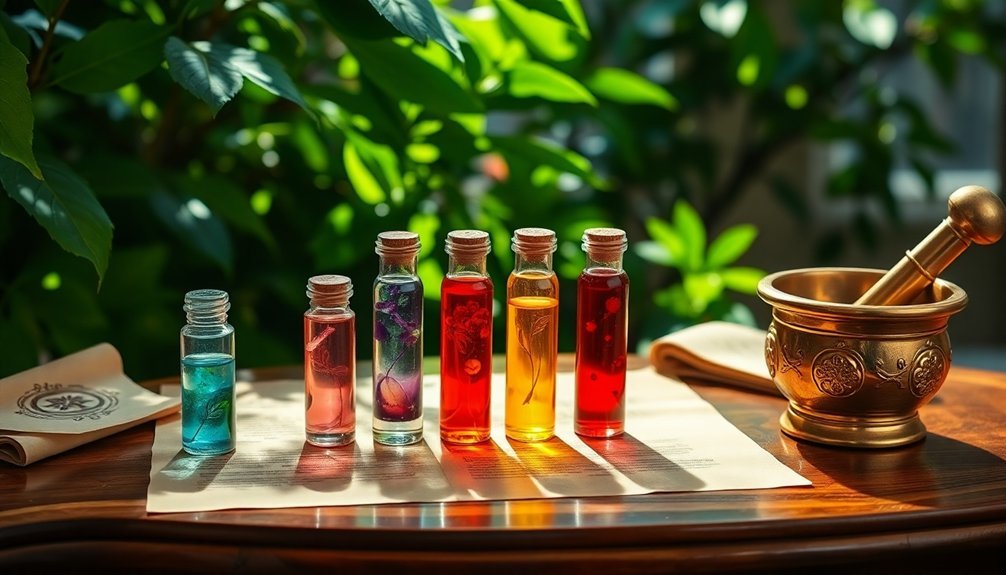
Ancient noble houses across Asia mastered the art of perfume preservation through meticulous storage practices that guaranteed their precious fragrances remained potent for generations.
You'll find their time-tested methods remarkably effective: store your perfumes in cool, dark spaces between 60-70°F, away from sunlight and artificial lighting.
Don't keep them in bathrooms or kitchens where humidity fluctuates. Instead, place them in sealed wooden boxes or opaque containers that block harmful UV rays.
Make sure you're keeping bottles tightly sealed when not in use, and avoid shaking them unnecessarily.
For travel, transfer small amounts to dedicated travel-sized vessels. If you live in a humid climate, use a humidifier to maintain ideal moisture levels around 50-60%.
These noble house techniques will help preserve your fragrances' intricate chemical compositions and delicate aromatic notes.
Frequently Asked Questions
How Did Ancient Perfumers Test Their Blends for Longevity and Potency?
You'll find ancient perfumers tested blends through historical documentation, aging in cool dark spaces, expert sensory evaluation, and cultural feedback. They'd monitor scents over months to guarantee proper bonding and stability.
What Containers Were Traditionally Used to Store Precious Perfume Ingredients?
You'll find ancient perfumers stored precious ingredients in clay, stone, metal, and glass containers. They'd choose materials based on ingredient sensitivity, with non-porous options like stone and glass being particularly favored.
How Did Seasonal Changes Affect Perfume Production in Ancient Asia?
You'll notice how seasons greatly impacted ingredient availability, with perfumers adapting their blends to match climate changes. They'd harvest specific materials during ideal times and adjust formulas for different ceremonial requirements.
Did Different Social Classes Use Different Types of Applicators for Perfumes?
Yes, you'd find nobles using ornate jade and gold applicators, while middle classes relied on ceramic or wooden tools. Lower classes often applied perfumes with simple reed sticks or their hands.
What Ancient Techniques Were Used to Extract Fragrances From Fresh Flowers?
You'll find ancient societies used four main techniques to extract floral fragrances: distillation with steam and water, pressing to squeeze oils, enfleurage using fats to absorb scents, and maceration by soaking flowers.
In Summary
You've now revealed the ancient art of Asian perfumery through these seven traditional techniques. From Tang Dynasty elements to Buddhist temple formulas, you're equipped to create your own exotic blends. Remember to honor these time-tested methods while adding your personal touch. Whether you're making aromatic pastes or preserving delicate scents, you'll find these ancient secrets bring depth to your modern perfume practice.
References
- https://asianartnewspaper.com/fragrance-from-china/
- https://www.scentopia-singapore.com/common-perfume-ingredients.html
- https://eclass.uoa.gr/modules/document/file.php/ISLL125/MLA+Handbook+for+Writers+of+Research+Papers.pdf
- https://beautinow.com/origins-history-of-perfume/perfume-in-ancient-china/
- https://karmakamet.co.th/en/product/traditional-asian-perfume-sachet/
- https://trybuna.info/swiat/chinas-famous-traditional-fragrances/
- https://boisdejasmin.com/2024/08/milk-sandalwood-fragrance-from-the-chinese-book-of-incense.html
- https://www.178wing.ang.af.mil/Portals/69/documents/afh33-337.pdf?ver=2016-12-15-101008-313
- https://www.scentopia-singapore.com/history-of-perfumery-in-asia.html
- https://www.iflscience.com/newly-identified-ancient-chinese-incense-ingredients-reveals-distance-of-early-trade-routes-63684

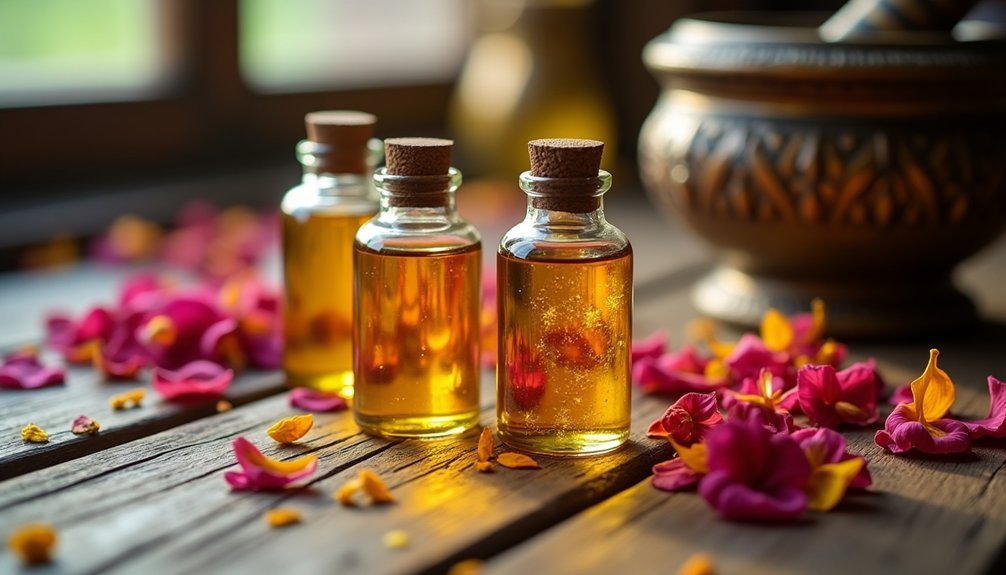



Leave a Reply